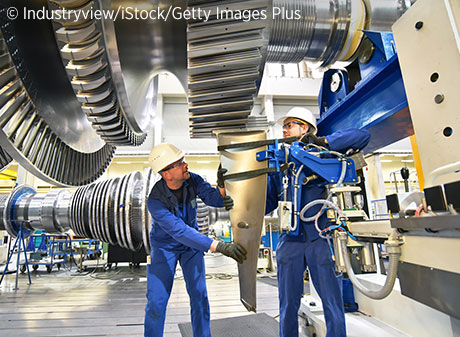Forecasters See Lower U.S. GDP Growth in 2020 as Headwinds Continue
KEY TAKEAWAYS
- Though the pace of real GDP growth has slowed this year, there are few signs that the longest U.S. expansion is on its last legs.
- The consensus of professional forecasters is that real GDP growth will dip below 2% in 2020.
- Real GDP growth in 2020 could rise above 2% if the economy’s headwinds—trade disputes and slowing global growth—were to diminish.

After showing considerable strength in the first quarter of 2019, the pace of real gross domestic product (GDP) growth has since slowed modestly. Labor market conditions remain healthy, as the number of job openings continues to outpace the number of unemployed people. By contrast, inflation—as measured by the all-items personal consumption expenditures price index (PCEPI)—has remained low; through September, the inflation rate was about 0.5 percentage points below the 2% inflation target of the Federal Open Market Committee (FOMC).
Although the U.S. economy is exhibiting trend-like growth, many businesses continue to face brisk headwinds related to the trade tussle with China and slowing global growth. To help mitigate these threats, the FOMC has reduced its federal funds target range by 75 basis points this year; the range is now 1.50% to 1.75%. Still, the consensus of professional forecasters is that real GDP growth will dip below 2% in 2020 and that inflation will modestly firm closer to the Fed’s target rate. (See table below.) But if the headwinds facing the economy diminish, then modestly stronger growth is possible in 2020.
| Actual | Forecast | ||
|---|---|---|---|
| Percent Change (Q4/Q4) | 2018 | 2019 | 2020 |
| Real GDP | 2.5 | 2.2 | 1.8 |
| PCE Price Index | 1.9 | 1.5 | 1.9 |
| Percent (Average, Q4) | |||
| Unemployment Rate | 3.8 | 3.6 | 3.7 |
SOURCES: Federal Reserve Bank of Philadelphia and Haver Analytics
NOTE: Forecasts are from the fourth-quarter Survey of Professional Forecasters.
Good Times, Unsettled Times
The U.S. economy remains in record-setting territory, entering its 125th month of expansion on Nov. 1. The pace of real GDP growth has slowed from a 3.1% annual rate in the first quarter to a 2% growth rate in the second quarter, and then to a 1.9% growth rate in the third quarter. But there are few signs that the expansion is on its last legs. Indeed, if anything, the current growth rate is consistent with the economy’s potential rate of growth—which most economists estimate to be between 1.75% and 2%.
The economy’s recent performance is built on some pillars that look reasonably sturdy and some pillars that exhibit troubling cracks. Worrisomely, the pace of business capital expenditures (fixed investment) is the pillar that looks the shakiest. Weak business fixed investment tends to be a signal that firms see impediments to profitably deploying their scarce resources. And since the domestic manufacturing sector is an important provider of capital goods to firms, slowing business fixed investment leads to fewer orders and reduced activity at the nation’s factories. Thus, weaker capital spending has potentially important implications.
In the current macroeconomic environment, there are two main impediments facing many manufacturing and nonmanufacturing firms as well as farmers: increased tariffs and slower global growth. These two developments have increased costs, trimmed profit margins and reduced sales to overseas markets (i.e., exports).
By contrast, the U.S. consumer remains the economy’s strongest pillar. The strength in consumption reflects several factors—most notably labor market conditions. Monthly gains in nonfarm payrolls have averaged slightly less than 170,000 thus far in 2019, helping to drive the unemployment rate to its lowest level in roughly 50 years. Nominal wage growth has remained around 3% over the past year, which translates into solid real wage gains of about 1.5% after accounting for inflation. The latter is broadly consistent with the underlying pace of labor productivity growth. But consumption spending has also been boosted by continued solid gains in household wealth—driven by double-digit gains in equity prices and steady increases in house prices.
The economy has also received a boost from other areas. Notably, residential housing construction (fixed investment) has rebounded modestly; in the third quarter, it contributed positively to real GDP growth for the first time in about two years. The FOMC’s rate cuts have provided a kick-start to the mortgage market and the housing industry.
Real GDP growth has also received a boost from government expenditures, as federal government outlays are on pace this year to be the strongest in a decade. Moreover, the St. Louis Fed’s Financial Stress Index indicates that financial conditions remain supportive for continued gains in economic activity.
Available data in October and November point to real GDP growth of around 2% in the fourth quarter of 2019. Thereafter, real GDP growth will slow a bit further next year and dip below 2%, according to the Survey of Professional Forecasters consensus. Forecasters also see a roughly 1 in 3 probability of a recession developing in 2020 or 2021, according to the Blue Chip consensus. But if the impediments noted earlier diminish, the FOMC’s insurance cuts could trigger a rebound in economic activity that pushes real GDP growth back above 2%.
Conflicting Inflation Signals
Inflation pressures and inflation expectations generally remain subdued, thanks to energy prices declining over the past year. Measured from four quarters earlier, the headline (all items) consumer price index (CPI) was up by 1.8% in the third quarter, while the headline PCEPI was up by 1.4%. By contrast, core CPI inflation—which excludes energy and food prices—rose by 2.3% in the third quarter, which was the largest increase in 11 years. However, the core PCEPI increased only by 1.7% in the third quarter from a year earlier. Financial market participants, as well as the St. Louis Fed’s Price Pressures Measure, continue to see a low probability of a sizable increase in inflation over the medium term.
Kathryn Bokun, a research associate at the Bank, provided research assistance.
Views expressed in Regional Economist are not necessarily those of the St. Louis Fed or Federal Reserve System.
For the latest insights from our economists and other St. Louis Fed experts, visit On the Economy and subscribe.
Email Us



